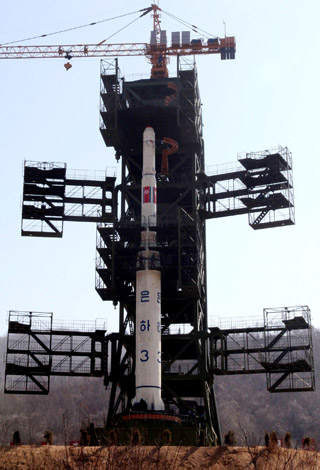North Korea has entered the space age, orbiting its first satellite, from a Taepodong-3 (Unha-3) rocket launch at 00:49 GMT on 12 December from the Sohae launch base at Tongchang-ri, on North Korea's west coast.
US Strategic Command has confirmed the Kwangmyongsong 3-2 spacecraft - described by North Korean sources as an Earth observation satellite built for the North Korean Institute for Electronic War, and thought to weigh about 100kg (220lb) - is in orbit: apogee 588km, perigee 495, inclination 97.4˚, period 95min 29s.
 |
|---|
Rex Features |
The flight, which took the rocket on a southward trajectory over the Yellow and Philippine seas, raised international protests. Neighbouring Japan cited concerns that North Korea would be able to convert such a rocket into a ballistic missile to carry nuclear weapons. North Korea has exploded nuclear devices before and is thought to be working on a nuclear missile warhead.
There were three failed orbital attempts prior to this flight: a Taepodong-3 (Unha-3) launch carrying the original Kwangmyongsong 3 satellite suffered a launch failure in April this year after a first-stage failure.
Before that, North Korea announced it had made a successful orbital launch in August 1998 from the Musudan-ri launch site on the east coast of North Korea using a Taepodong-1 launch vehicle. While North Korea claimed success, US Space Command noted the flight had ended in failure with the third stage of the rocket landing in the sea. As it was, there were suspicions in neighbouring nations that this was really a test of North Korea's ballistic missile technology rather than a true orbital attempt.
In April 2009, North Korea claimed to have launched its Kwangmyongsong 2 satellite in a launch attempt using the Taepodong-2 rocket, again from Musudan-ri. However, US Space Command and Russian space authorities again noted this flight ended in failure after a suspected second-stage fault.
After this record of failure, and with this latest success, it has been alleged Iran has been giving North Korea technical assistance. Iran has successfully launched its own satellites using similar rocket technology and there are fears an exchange of rocket and nuclear know-how is taking place.
Kwangmyongsong 3-2 has been given international number 2012-072A.
Source: Flight International


























